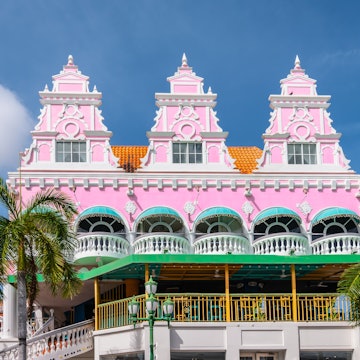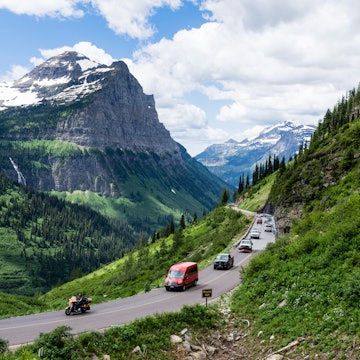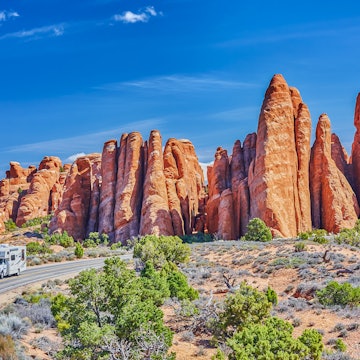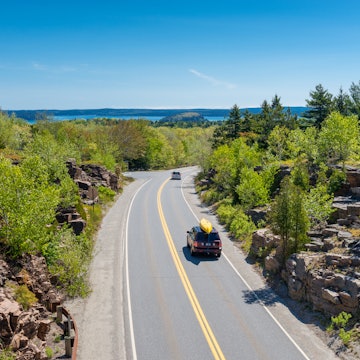

From epic coastal drives to historic maritime villages to whale watching in the Bay of Fundy, read all about the best places to go in Nova Scotia © NetaDegany / Getty Images
On a map, Nova Scotia resembles a duck or a lobster – both fitting references for a province defined by its proximity to the North Atlantic.
Yet the landscapes, seascapes and, um, people-scapes in Canada’s second-smallest province are as varied as anywhere in the country. Take an hour’s drive in almost any direction, and you’ll get a full switch-up of both scenery and cultural heritage.
A stretch of one coastline washed by the world’s highest tides is dotted with French Acadian villages and their tall stone and wooden churches. The opposite coast of rocky headlines is interrupted by great crescents of silver sand and fishing villages founded by European and Black Loyalist settlers. Between the two, the fertile Annapolis Valley plays home to an upstart wine region. In the north, undulating highlands attracted Gaelic Scottish settlers who recognized Cape Breton Island as a Scotland look-alike. And everywhere in Nova Scotia, the Indigenous Mi’kmaq have roamed for thousands of years, using the rivers as highways and the seashore as their pantry.
The hardest question? Where to focus your visit. Let us help you build a Nova Scotia itinerary filled with all the best places to visit along the province’s 7500km (4660 miles) of seabound coast.
Let us help you build your itinerary with the best things to do in Nova Scotia

1. Halifax
Best for a day on the waterfront
A stroll along the Halifax harborside boardwalk is the best way to get to know Nova Scotia’s capital city and its rich history. Begin at the Canadian Museum of Immigration at Pier 21, where waves of immigrants entered Canada. Then, learn about Halifax’s grim role in the Titanic disaster at the Maritime Museum of the Atlantic.
Queen’s Marque is the city’s flashy new waterfront development, complete with high-end accommodations, the city’s best restaurants and a stairway into the sea. Come evening, bar hop up the hill for live music at venues like The Carlton and the Split Crow.
Detour: Cross Halifax harbor aboard one of the bathtub-like ferries that chugs every 15 to 30 minutes to Dartmouth, whose 10-block downtown is like an urban village with a throwback feel. Chuck axes at the Timber Lounge, shop for vinyl at Taz or Renegade Records, or sip a Negroni at Dear Friend Bar.
2. Sou’West Nova
Best for exploring the province’s multicultural roots
Several culturally distinct peoples share the southern tip of Nova Scotia (known locally as Sou’West Nova). The French Shore is where Acadians resettled in 1763 following a forced exile hugs the Bay of Fundy coastline. Other Acadians settled in the Pubnico area – where today fishing boats are docked two and three abreast, seafood is served in heaping platters and the Historic Acadian Village brings their past alive. In Shelburne and neighboring Birchtown, the story of enslaved Africans who were freed and escaped themselves is told at the Black Loyalist Heritage Centre. The month-long Nova Scotia Lobster Crawl every February animates this region with delicious events, making it a wonderful place to visit in winter.
3. Digby Neck
Best place for whale watching
A long, finger-like peninsula points from the scallop fishing port of Digby into the Bay of Fundy, which leads to ferry-linked Long and Brier Islands. From these rocky, remote knuckles of land, whale-watching tours depart all day long in search of humpback, minke, gray and rare northern right whales. Seabirds, dolphins and seals add vivacious variety to every trip.
Local tip: If speed is your thing, book a whale-watching tour aboard a Zodiac; if you want slow and steady, opt for a converted fishing boat. Either way, know your tolerance for motion sickness – and prepare accordingly.

4. Kejimkujik National Park
Best for unspoiled wilderness
There is no place further from the madding crowds (if crowds are even possible in Nova Scotia) than the lakes, rivers and trails sprawling across the swath of wilderness fondly known as Keji, where the haunting call of the loon is often the only sound.
Renting a kayak or canoe to explore the waterways is the best way to take in the park’s majesty. And don’t miss a tour of Canada’s second-largest collection of petroglyphs, led by a Mi’kmaw guide who will describe how their Indigenous ancestors etched their observations in stone.
Detour: Book a frontcountry site for comfortable (if moderately crowded) camping. Book a backcountry site for wilderness adventure.
5. Annapolis Valley
Best for winery tours and “u-picks”
The breadbasket of Nova Scotia and home to many “u-picks” (pick-your-own farm stands), the Annapolis Valley is nestled between time-worn mountains and forested ridges. In May, the air fills with the heady perfume of apple blossoms; in the fall, the grapes get harvested and find their way into Annapolis Valley specialties like Tidal Bay, a crisp white that pairs perfectly with Nova Scotia seafood.
Detour: If you’d rather not drive, book a winery tour aboard the Magic Winery Bus or Grape Escapes.

6. Cliffs of Fundy Geopark
Best for natural history
Recently designated the Cliffs of Fundy Geopark, the Parrsboro Shore is one of the world’s richest natural history sites. Worn by the world’s highest tides, the coastal cliffs give up prehistoric ghosts in the form of fossils from the pre-dinosaur Carboniferous era. Stop at the Fundy Geological Museum in Parrsboro to experience a time when Nova Scotia was a humid swamp crawling with giant amphibians. Then head to the Joggins Fossil Centre for a guided tour of the eroding cliffs to see fossils of prehistoric trees.
Local tip: Make a stop for lunch in Advocate Harbour’s Wild Caraway restaurant, where most dishes feature locally foraged and restaurant-grown ingredients.
7. 100 Wild Islands
Best for sea kayaking
The elegant name 100 Wild Islands trips off the tongue – though this coastal wilderness is in reality a seascape of 282 tiny polka-dot specks, some forested, some beach-framed. Facing 32km (20 miles) of coastline, the seemingly endless collection of bumps above the waves is best explored via guided kayak tour with outfitters like Coastal Adventures and the Norse Cove Camping and Kayak Centre. Those who book at Murphy’s Camping can hitch a ride with the owner out to an island to gather wild mussels.

8. Chester, Mahone Bay and Lunenburg
Best seaside towns
Begin in Chester, a summer sailing destination for two centuries, by shooting a game of pool and tucking into fish and chips at the Fo’c’sle (Nova Scotia’s oldest tavern, it goes by the nickname “Chester’s living room”). In Mahone Bay, stroll by the three shoulder-to-shoulder churches and numerous artisan shops to discover why many consider this Nova Scotia’s most picture-perfect town.
The UNESCO-listed heritage town of Lunenburg is home to the Bluenose II, a replica of the famous schooner that graces Canada’s dime. This seafaring place is chock full of seafood restaurants, historic inns and ocean-themed sites like the Fisheries Museum of the Atlantic.
Detours: From these towns, excursion options abound. Head to Peggy’s Cove to see the white lighthouse perched on ocean-sculpted rocks. Take the ferry to Big Tancook for an island day trip. Set off on a boat tour to the island that gave the TV show The Curse of Oak Island its name. Or drive to Blue Rocks, a checkerboard of coves, islands and tiny fishermen’s homes and sheds.
9. Tatamagouche
Best for experiencing small-town Nova Scotia
For such a tiny town, Tatamagouche is both a destination in itself and a great base for exploring Nova Scotia’s north shore. Once a locale for the reality TV show The Week the Women Went, the town has re-imagined itself after a long downturn. Today, stops like Tatamagouche Brewing, Appleton Chocolates and Creamery Square – named for the town’s agrarian roots – are the rewards for a stroll down Main St.
Drive south to see the water-powered Balmoral Grist Mill (the oatcakes are delicious). Then head east to Seafoam Lavender to walk among the fragrant flowers. In Pictou, see a replica of the Hector, the ship that deposited the first Scots here.
Local tip: Stay and dine at the Train Station Inn – which occupies (yes) a former train station and railway cars, including a refurbished 1928 dining car.
10. Fortress Louisbourg
Best for immersing yourself in history
The largest historic reconstruction project in North America sits on a remote, often fog-bound point at the eastern extremes of Cape Breton Island. Entering Fortress Louisbourg evokes the French fortified outpost and town as it might have looked in the early 18th century. Inside the fortified walls, visitors encounter costumed interpreters and farm animals as they roam among 80 rebuilt structures. Dine on period-accurate meals at Hôtel de la Marine or Grandchamps Restaurant, and book an overnight stay in the comfortable Lartigue House, the barely adequate guardhouse or the downright scary prison.

11. The Cabot Trail
Best for a scenic drive
It’s impossible to overstate the beauty of the drive around northwestern Cape Breton known as the Cabot Trail. Much of the route winds through mountaintop wilderness and coastal villages. Along the way, you’ll experience 200 years of Scottish heritage at the Gaelic College in St Ann’s, 300 years of French Acadian culture at Les Trois Pignons museum and gallery in Cheticamp, and 10,000 years of Indigenous Mi’kmaw traditions at Kluskap Ridge RV & Campground near Englishtown. In fall, the mountainsides run riot with color, making the Cabot Trail a fantasy road trip for leaf peepers.
Local tip: Begin and end a Cabot Trail drive on the saltwater Bras d’Or Lake in Baddeck. Drive north so views are on your side of the road. Take advantage of the many lookouts, where interpretive signs supplement the sheer beauty of the views.
Keep planning your trip to Nova Scotia:
Explore the varied terrain of the province on these top road trips
Here’s how to get around Nova Scotia
Traveling on a budget? Here are ways to save money on your trip
















